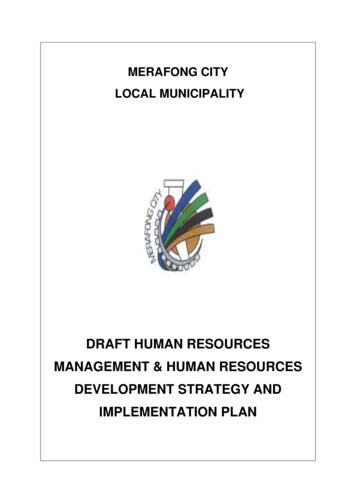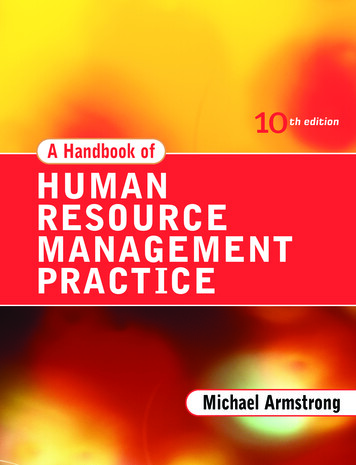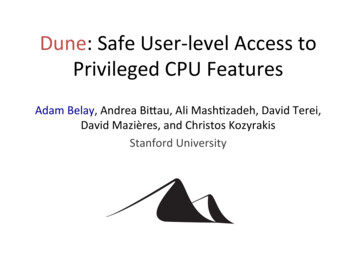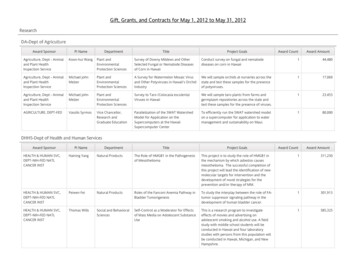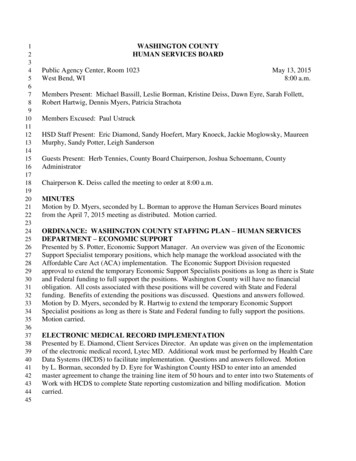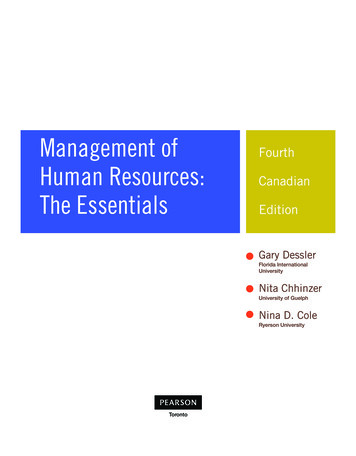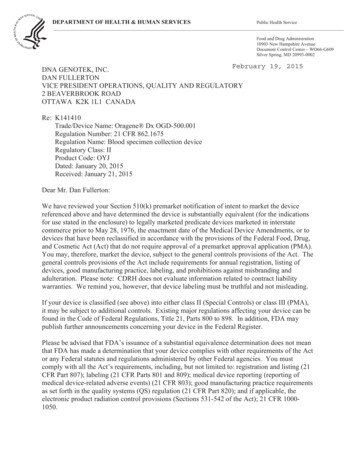
Transcription
DEPARTMENT OF HEALTH & HUMAN SERVICESPublic Health ServiceFood and Drug Administration10903 New Hampshire AvenueDocument Control Center – WO66-G609Silver Spring, MD 20993-0002February 19, 2015DNA GENOTEK, INC.DAN FULLERTONVICE PRESIDENT OPERATIONS, QUALITY AND REGULATORY2 BEAVERBROOK ROADOTTAWA K2K 1L1 CANADARe: K141410Trade/Device Name: Oragene Dx OGD-500.001Regulation Number: 21 CFR 862.1675Regulation Name: Blood specimen collection deviceRegulatory Class: IIProduct Code: OYJDated: January 20, 2015Received: January 21, 2015Dear Mr. Dan Fullerton:We have reviewed your Section 510(k) premarket notification of intent to market the devicereferenced above and have determined the device is substantially equivalent (for the indicationsfor use stated in the enclosure) to legally marketed predicate devices marketed in interstatecommerce prior to May 28, 1976, the enactment date of the Medical Device Amendments, or todevices that have been reclassified in accordance with the provisions of the Federal Food, Drug,and Cosmetic Act (Act) that do not require approval of a premarket approval application (PMA).You may, therefore, market the device, subject to the general controls provisions of the Act. Thegeneral controls provisions of the Act include requirements for annual registration, listing ofdevices, good manufacturing practice, labeling, and prohibitions against misbranding andadulteration. Please note: CDRH does not evaluate information related to contract liabilitywarranties. We remind you, however, that device labeling must be truthful and not misleading.If your device is classified (see above) into either class II (Special Controls) or class III (PMA),it may be subject to additional controls. Existing major regulations affecting your device can befound in the Code of Federal Regulations, Title 21, Parts 800 to 898. In addition, FDA maypublish further announcements concerning your device in the Federal Register.Please be advised that FDA’s issuance of a substantial equivalence determination does not meanthat FDA has made a determination that your device complies with other requirements of the Actor any Federal statutes and regulations administered by other Federal agencies. You mustcomply with all the Act’s requirements, including, but not limited to: registration and listing (21CFR Part 807); labeling (21 CFR Parts 801 and 809); medical device reporting (reporting ofmedical device-related adverse events) (21 CFR 803); good manufacturing practice requirementsas set forth in the quality systems (QS) regulation (21 CFR Part 820); and if applicable, theelectronic product radiation control provisions (Sections 531-542 of the Act); 21 CFR 10001050.
Page 2—Mr. FullertonIf you desire specific advice for your device on our labeling regulations (21 CFR Parts 801 and809), please contact the Division of Industry and Consumer Education at its toll-free number(800) 638 2041 or (301) 796-7100 or at its Internet forYou/Industry/default.htm. Also, please notethe regulation entitled, “Misbranding by reference to premarket notification” (21 CFR Part807.97). For questions regarding the reporting of adverse events under the MDR regulation (21CFR Part 803), please go Problem/default.htm for the CDRH’s Officeof Surveillance and Biometrics/Division of Postmarket Surveillance.You may obtain other general information on your responsibilities under the Act from theDivision of Industry and Consumer Education at its toll-free number (800) 638-2041 or (301)796-7100 or at its Internet forYou/Industry/default.htm.Sincerely yours,Katherine Serrano -AFor: Courtney H. Lias, Ph.D.DirectorDivision of Chemistry and Toxicology DevicesOffice of In Vitro Diagnosticsand Radiological HealthCenter for Devices and Radiological HealthEnclosure
510(k) SummaryThis summary of the 510(k) safety and effectiveness information is being submitted in accordance withthe requirements of SMDA 1900 and CFR 807.92.Date:16 January 2015Submitter:DNA Genotek Inc.2 Beaverbrook Road, Ottawa,Ontario K2K 1L1 CanadaContact:Dan FullertonVice President Operations, Quality & Regulatory AffairsTel: (613) 723‐5757 Ext. 213, Fax: (613) 368‐4628Email: dan.fullerton@dnagenotek.comDevice Proprietary NameOragene DxFormat: OGD‐500.001Common namesKit for collection of human DNA, Saliva kit, Sample collection kit for use inover‐the‐counter genetic testingProposed DeviceRegulatory ClassificationRegulation: 21CFR 862.1675 Blood specimen collection devicePanel: Chemistry (75)Classification: Class IIProduct Code: OYJ DNA Specimen Collection, SalivaPredicate DeviceOragene Dx OGD‐500 (k110701)Regulation: 21CFR 862.1675 Blood specimen collection devicePanel: Chemistry (75)Classification: Class IIProduct Code: OYJ DNA Specimen Collection, SalivaINTENDED USEIntended useOragene Dx OGD‐500.001 is intended for use in the non‐invasive collection of saliva samples. DNAfrom the saliva sample is isolated, stabilized, and suitable for over‐the‐counter use with FDA cleared,approved, or legally marketed exempt DNA carrier screening genotyping tests. Saliva samples collectedusing Oragene Dx OGD‐500.001 are stabilized and can be transported and/or stored long term atambient conditions.Indications for useSee Intended Use, above.5‐2
Special conditions for use statementIntended for adults of reproductive age.DEVICE DESCRIPTIONOragene Dx family of collection devices offers reliable collection, stabilization, transportation and long‐term ambient temperature storage of human DNA from saliva. Oragene Dx OGD‐500.001 is a non‐invasive alternative for collecting high quality and quantity DNA and is suitable for use in over‐the‐counter molecular genotyping applications. Oragene Dx OGD‐500.001 consists of a collection tube witha funnel lid attached (containing a stabilizing liquid). Saliva is delivered directly by spitting into thecollection tube. Saliva collection can take place at home, in a laboratory setting, physician’s office, or inthe field. Untrained (naïve) or professional users can carry out saliva collection. After saliva is collected,the stabilizing liquid is mixed with the sample. A small cap is provided to close the tube for transport andstorage (funnel with lid is removed and discarded). Upon contacting saliva cells, the stabilizing liquidlyses cellular and nuclear membranes to release and stabilize nucleic acids (DNA). Samples can beimmediately processed, transported or stored for future use. Samples can be shipped at ambienttemperature to the laboratory for processing. Oragene Dx samples are stable at room temperature forup to 12 months. Device and sample integrity are preserved during typical ambient transport and storageconditions.5‐3
SUBSTANTIAL EQUIVALENCE INFORMATIONThe following table outlines the similarities and differences between Oragene Dx OGD‐500 (predicate)and Oragene Dx OGD‐500.001 (proposed device).Table 1. Comparison between Predicate and Proposed devicePrinciple,Materials andTechnologyOragene Dx OGD‐500Oragene Dx OGD‐500.001(predicate – k110701)(proposed device)Intended UseOragene Dx is intended for usein the non‐invasive collection ofsaliva samples. DNA from thesaliva sample is isolated,stabilized, and suitable for usein FDA cleared moleculardiagnostic applications. Salivamay be collected by spittingdirectly into the Oragene Dxcontainer or may betransferred into theOragene Dx container using asponge. Saliva samplescollected using Oragene Dx arestabilized and can betransported and/or stored longterm at ambient conditions.PrescriptionOragene Dx OGD‐500.001 isintended for use in the non‐invasive collection of salivasamples. DNA from the salivasample is isolated, stabilized,and suitable for over‐the‐counter use with FDA cleared,approved, or legally marketedexempt DNA carrier screeninggenotyping tests. Saliva samplescollected using Oragene DxOGD‐500.001 are stabilized andcan be transported and/orstored long term at n‐invasive collection ofbiological samples deliveredinto a non‐sterile plasticcollection tubeNon‐invasive collection ofbiological samples deliveredinto a non‐sterile plasticcollection tubeXTube materialPlasticPlasticXSamplesourceHuman salivaHuman salivaXAdditiveNucleic acid stabilizationsolutionNucleic acid stabilizationsolutionXSpecialconditions foruseSimilar DifferentXOver the counter5‐4X
Principle,Materials andTechnologyTransport andStabilityOragene Dx OGD‐500Oragene Dx OGD‐500.001(predicate – k110701)(proposed device)Pre‐collection Oragene Dx kitscan be transported attemperatures ranging from‐20 C to 50 CPost‐collection Oragene Dxsamples can be transported attemperatures ranging from‐20 C to 50 CPre‐collection Oragene Dx kitscan be stored at roomtemperature for up to 24monthsPost‐collection Oragene Dxsamples can be stored at roomtemperature for up to 12months (OGD‐500, OGD‐575,OYD‐500) and 3 months forOXD‐525PerformancePerformance has beenestablished with the eSensor Warfarin Sensitivity Saliva TestPre‐collection Oragene Dx kitscan be transported attemperatures ranging from‐20 C to 50 CSimilar DifferentXPost‐collection Oragene Dxsamples can be transported attemperatures ranging from‐20 C to 50 CPre‐collection Oragene Dx kitscan be stored at roomtemperature for up to 24monthsPost‐collection Oragene Dxsamples can be stored at roomtemperature for up to 12monthsPerformance has beenestablished with the 23andMePersonal Genome Service (PGS)Carrier Screening TestXThe similarities in intended use, materials, and technological characteristics show that Oragene Dx OGD‐500.001 (k141410) is substantially equivalent to Oragene Dx OGD‐500 (k110701). The differencestabulated above do not affect the safety and performance of Oragene Dx OGD‐500.001. Oragene DxOGD‐500 performance has been validated using GenMark Diagnostics’ FDA cleared eSensor WarfarinSensitivity Saliva Test. Oragene Dx OGD‐500.001 performance has been validated with the 23andMe PGSCarrier Screening Test.5‐5
PERFORMANCE ility of the Oragene Dx OGD‐500.001 collection device was validated when used with the23andMe PGS Carrier Screening Test. Reproducibility was demonstrated across multiple operators, daysand reagent lots (see PGS Carrier Screening Test co‐submission DEN140044).StabilityPre‐collection shelf‐lifeShelf‐life stability testing of the Oragene Dx device has been demonstrated (see k110701).The Oragene Dx OGD‐500.001 format is comprised of the same physical and chemical components asthe FDA cleared Oragene Dx OGD‐500 format; therefore, studies in k110701 support the following shelf‐life performance claims for OGD‐500.001: 24 months at room temperature 12 months at ‐20 5 C and 6 4 CPost‐collection sample stabilityPost‐collection sample stability of the Oragene Dx device (OGD‐500) has been demonstrated in studiesevaluating DNA yield, DNA concentration, A260/A280 ratio and microbial content (see k110701). TheOragene Dx OGD‐500.001 format is comprised of the same physical and chemical components as theFDA cleared Oragene Dx OGD‐500 format; therefore, studies in k110701 support the following samplestability performance claims for OGD‐500.001: 12 months at room temperature, ‐20 5 C or 6 4 C 3 months at 50 5 CSample Volume Tolerance and Limit of DetectionThe effect of overfilling or underfilling the Oragene Dx device has been evaluated (see k110701).Oragene Dx OGD‐500.001 format is comprised of the same physical and chemical components as theFDA cleared Oragene Dx OGD‐500 format. As demonstrated, underfilling the Oragene Dx device (OGD‐500) by 25% or 50% of target volume, or overfilling by 50% of target volume did not impactperformance. Collected samples ranged from as low as 0.58mL saliva to as much as 3.64 mL saliva. Asexpected the DNA yield was dependent on collected volume, but downstream performance was notaffected by over or under spitting.These results were further validated in a Consumer User Study where sample volume was measured insamples submitted from naive users in the over‐the‐counter setting of the 23andMe PGS CarrierScreening Test. Collected samples had a mean total sample volume (saliva stabilizing solution) of 4.25 0.56 mL (equivalent to mean of 2.25 mL saliva). 97.7% of samples contained the acceptable range of2.58 to 5.64 mL total sample.The 23andMe PGS Carrier Screening Test also requires a minimum DNA concentration. To ensure thisconcentration is met, the DNA concentration of every sample submitted for testing is measured. If the5‐6
extracted DNA concentration is below the minimum DNA concentration, re‐extraction is attempted. Ifre‐extraction is unsuccessful, the customer is contacted to submit a new saliva sample. 98.3% ofsamples in the study contained the minimum amount of DNA required for testing.Interfering SubstancesEndogenous SubstancesThe effect of potentially interfering endogenous substances on performance of saliva samples collectedwith the Oragene Dx OGD‐500.001 device on the 23andMe PGS Carrier Screening Test was evaluated(see PGS co‐submission DEN140044). Saliva samples were collected from 10 individuals. These salivasamples were sent to the contracted laboratory for DNA extraction and genotyping. At the contractedlaboratory, the following substances were spiked separately into an aliquot of each saliva sample beforeDNA extraction: salivary α‐amylase, hemoglobin, immunoglobulin A, and a combination of α‐amylase,immunoglobulin, and human serum albumin (total protein). An additional saliva sample aliquot was notspiked and served as the control. For each individual, genotypes of the samples containing eachendogenous substance were compared with the genotype of the original unadulterated sample(considered control) to determine percent concordance.This endogenous interference study yielded 100% concordant genotype calls for all samples and allendogenous substance conditions. The results of this study indicate that the presence of endogenoussubstances in human saliva does not affect the ability of the 23andMe PGS Carrier Screening Test tocorrectly assign genotypes to saliva samples.Exogenous SubstancesThe effect of potentially interfering exogenous substances on the performance of saliva samplescollected with the Oragene Dx OGD‐500.001 device on the PGS Carrier Screening Test has beenevaluated (see PGS co‐submission DEN140044). Saliva samples were collected from 5 individuals at 3time points – before consuming an exogenous substance (baseline), immediately (0 minutes) after, and30 minutes after – and sent to the contracted laboratory for DNA extraction and genotyping. For eachindividual, genotypes of the 0 and 30 minute samples were compared with genotypes of the baselinesample (considered control) to determine percent concordance. The following exogenous interferenceconditions were tested separately: eating food containing beef, eating food other than beef, drinking,chewing gum, and using mouthwash. Smoking was tested following the same methodology in a separatestudy.This interference study yielded 100% concordant genotype calls for all samples collected immediatelyafter and 30 minutes after consuming an exogenous substance or smoking. These data are consistentwith the package insert instructions, which require the consumer to take nothing by mouth for 30minutes prior to saliva collection.5‐7
Consumer User StudyPerformance of the Oragene Dx OGD‐500.001 device when used in the over‐the‐counter setting of the23andMe PGS Carrier Screening Test was evaluated. New 23andMe customers who registered their kitwithin consecutive 24‐hour periods were invited to participate in the study survey via email. Samplesfrom customers who completed the survey were shipped to the testing laboratory. Upon receipt at thetesting laboratory, each study sample was assessed for compliance to collection instructions and samplevolume, DNA concentration, and DNA purity (A260/A280 ratio) was assessed. User comprehension oftest instructions, including comprehension of sample collection instructions was also assessed.A total of 302 individuals completed the user comprehension survey and provided a saliva sample foranalysis. The majority of participants (96.3%) were naïve to the device and saliva collection process. Ofthe 302 samples evaluated, 98.3% contained the minimum amount of DNA required for testing,demonstrating that customers were able to follow sample collection instructions to obtain adequatesample for testing. See PGS co‐submission DEN140044 for additional user study information.A Flesch‐Kincaid reading analysis was performed on the collection device labeling and a reading gradelevel of 7.1 was obtained.CONCLUSIONThe submitted information in this premarket notification is complete and supports the safety andeffectiveness of the Oragene Dx OGD‐500.001 for over‐the‐counter use.5‐8
over‐the‐counter genetic testing Proposed Device Regulatory Classification Regulation: 21CFR 862.1675 Blood specimen collection device Panel: Chemistry (75) Classification: Class II Product Code: OYJ DNA Specimen Collection, Saliva Predicate Device Oragene Dx OGD‐500 (k110701)


